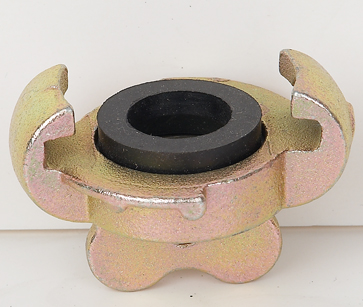Understanding Universal Couplings: Essential Components for Mechanical Systems
2025-02-12
When it comes to mechanical systems, the ability to transmit power efficiently and smoothly is paramount. This is where universal couplings come into play. As crucial components in many industrial applications, universal couplings are designed to connect two rotating shafts, allowing for the transfer of motion, torque, and power. Their ability to compensate for misalignment and accommodate angular movement makes them indispensable in a wide range of industries. In this blog, we’ll take a closer look at universal couplings, their importance, how they work, and why they are essential for maintaining the reliability of mechanical systems.
What is a Universal Coupling?
A universal coupling, often referred to as a universal joint or U-joint, is a mechanical component used to connect two shafts at an angle. It facilitates the transmission of rotary motion between shafts that are not aligned in a straight line, making it possible for power to be transferred despite variations in the angular positions of the connected shafts. Universal couplings can handle angular misalignment, offset, and axial displacement, which is crucial for systems where the shafts cannot remain perfectly aligned due to structural limitations or the design of the equipment.
Commonly used in applications such as automotive drives, heavy machinery, conveyors, and industrial pumps, universal couplings help to ensure smooth operation and prevent damage from misalignment.
How Do Universal Couplings Work?
Universal couplings consist of two yoke-like components and a cross-shaped central piece, which allows the input and output shafts to move relative to each other at an angle. When one of the connected shafts rotates, the cross in the universal coupling transmits rotary motion to the other shaft, regardless of the angle between them.
A key feature of universal couplings is their ability to maintain a constant velocity ratio between the shafts, even as they operate at an angular misalignment. This means the rotational speed of the output shaft will remain relatively consistent with the input shaft, despite any angular differences. This characteristic makes universal couplings highly effective in applications where continuous, smooth motion is required.
While universal couplings are incredibly versatile, it’s important to note that they have limitations. The amount of angular misalignment they can accommodate is generally limited, and excessive misalignment or high speeds may result in vibrations, noise, or premature wear of the coupling components.
Types of Universal Couplings
There are several types of universal couplings, each suited for specific applications. Some of the most common types include:
1. Single Universal Coupling:
This is the most basic type, where a single U-joint connects two shafts at an angle. It is typically used in systems where only a small angular misalignment is expected.
2. Double Universal Coupling:
In this type, two universal joints are used in tandem to allow for a greater range of angular misalignment. Double universal couplings are ideal for applications where the connected shafts have significant angular displacement, such as in drive shafts for vehicles.
3. Cardan Shaft:
A Cardan shaft is a type of universal coupling used primarily in automotive applications. It consists of two U-joints that are connected in a way that minimizes the variation in velocity between the input and output shafts. This type of coupling is commonly used in drive shafts, particularly in rear-wheel-drive vehicles.
4. Flexible Universal Coupling:
Flexible couplings allow for some amount of axial movement and compensate for minor misalignments in the shaft. They are typically used in systems that require flexibility and where slight variations in shaft alignment may occur during operation.
5. Constant Velocity (CV) Joint:
A constant velocity joint is a specialized type of universal coupling designed to maintain a constant rotational speed, even with a large degree of angular misalignment. This type is often used in automotive and heavy machinery applications, where maintaining a consistent velocity is critical for smooth operation.
Applications of Universal Couplings
Universal couplings are found in a wide range of industries, and their versatility makes them suitable for various applications:
1. Automotive Industry:
In automobiles, universal couplings are used in drive shafts to transmit power from the engine to the wheels. They are essential in rear-wheel-drive vehicles, where the power needs to be transferred through a series of shafts at different angles. The constant velocity joints in cars ensure that the wheels rotate smoothly, even as the vehicle’s suspension moves and the angles change.
2. Industrial Machinery:
Universal couplings are used in industrial machines and equipment, such as conveyors, pumps, and compressors, where shafts may not always align perfectly. By providing flexibility and compensating for misalignment, universal couplings ensure that machinery runs smoothly and without the risk of damage.
3. Agricultural Machinery:
Agricultural equipment, such as tractors and harvesters, often requires universal couplings to connect various rotating shafts in power take-off (PTO) systems. These couplings ensure that power is efficiently transferred to various components, even when the shafts are at different angles due to the machine’s design or terrain conditions.
4. Aerospace:
In aerospace applications, universal couplings are used in systems like landing gears and control systems. They help transmit mechanical power and motion without compromising the performance of the aircraft, even in environments with significant vibrations and misalignment.
5. Robotics:
In robotic systems, universal couplings allow for flexible movement and motion between connected components, ensuring that the robot’s movements are precise and effective. They are often used in servo motors and actuators to transmit torque and power to different parts of the robot’s structure.
6. Marine Industry:
Universal couplings are also used in marine applications, such as connecting the engine to the propeller shaft. These couplings help ensure the efficient transfer of power even when the angles between the shafts change due to movement in the water.
Advantages of Universal Couplings
- Compensation for Misalignment: Universal couplings are designed to handle both angular and parallel misalignments, ensuring the efficient transmission of power even when the shafts are not perfectly aligned.
- Smooth Power Transfer: These couplings allow for smooth transmission of torque, preventing jerky or uneven motion that could cause damage to equipment.
- Durability and Reliability: Universal couplings are built to withstand heavy loads and harsh conditions, offering long-lasting performance in demanding applications.
- Versatility: With various designs available, universal couplings can be used in a wide array of industries and applications, making them highly versatile.
Conclusion
Universal couplings are an essential component in many mechanical systems, providing flexibility, efficiency, and reliability. Their ability to transmit power between misaligned shafts, compensate for angular movement, and maintain smooth rotational speed makes them indispensable in a variety of industries, from automotive to industrial machinery. Whether you're looking for a simple solution for a small machine or a more complex coupling for high-performance equipment, universal couplings are an effective choice to ensure optimal operation and extend the life of your machinery.



